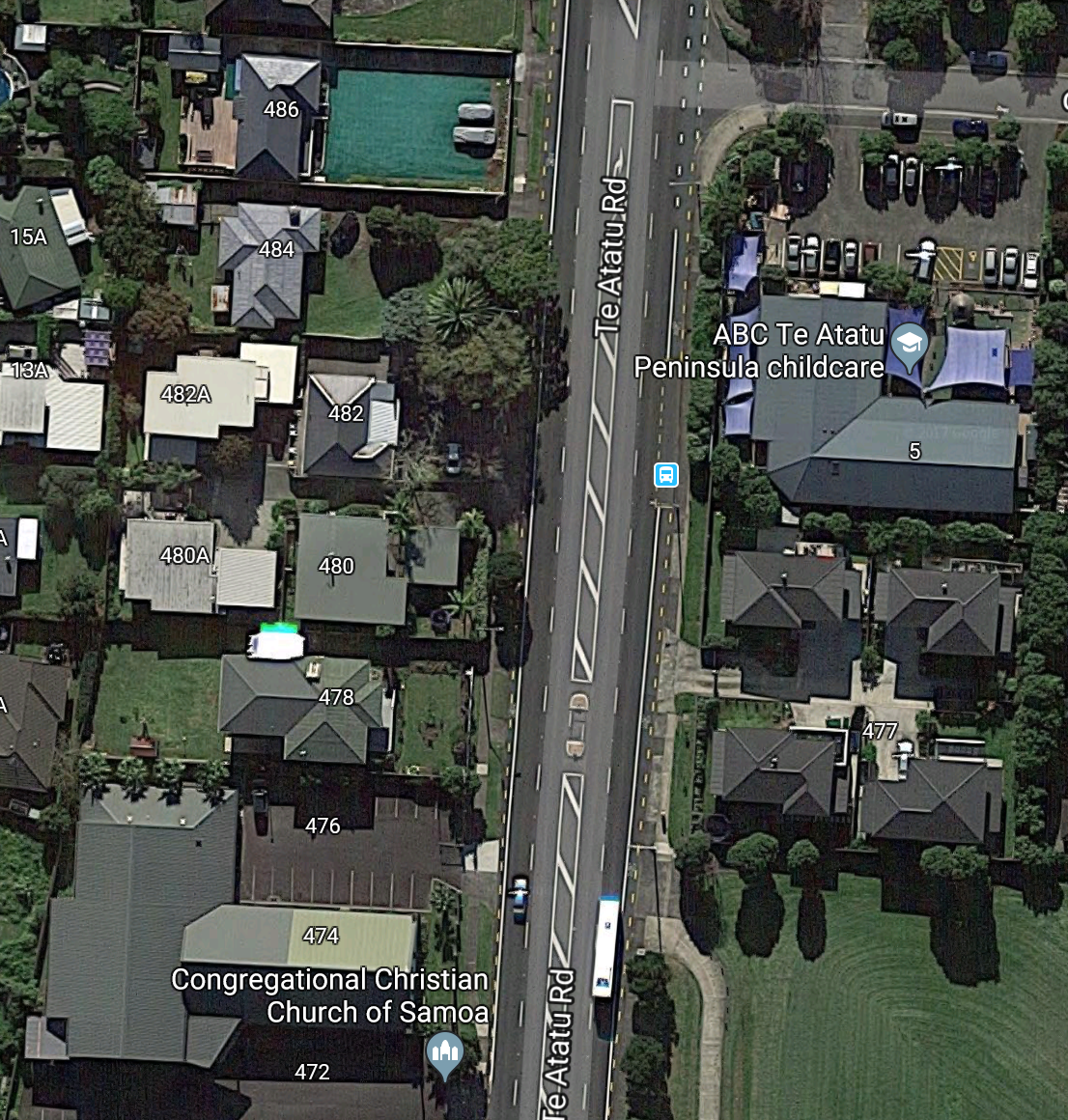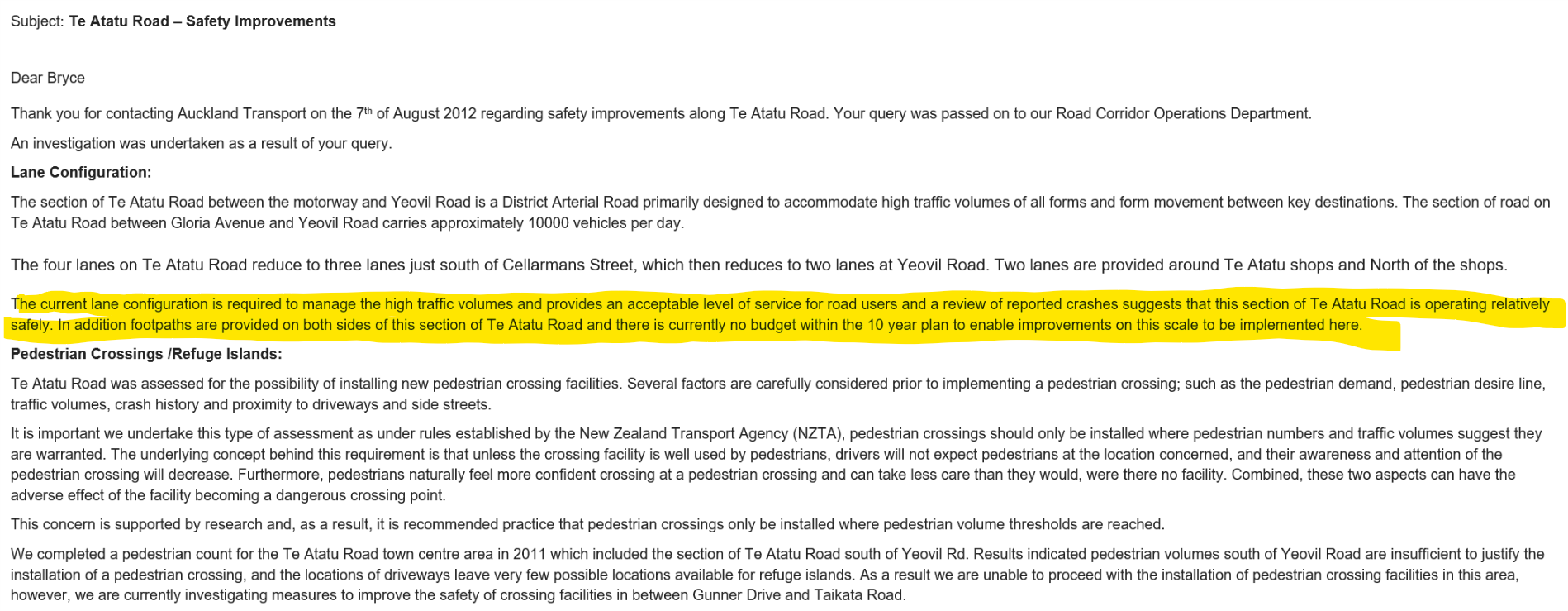Friend of Bike Auckland (and former committee member) Bryce Pearce has been mulling over the tragedy on Te Atatu Rd last week, in the light of long-running attempts by the local community to make this stretch of road safer for everyone. This post also appears on his blog, the Orewa Urbanist.
I’ve written and deleted this post a few times since Thursday evening’s tragic death of John Bonner on Te Atatu Road. Now, we do not know how events unfolded, so I’m not interested in arguing the finer points. (Editorial note: and with the crash still under investigation it wouldn’t be appropriate to speculate on the details, so please, let’s not.) But the safety of this road is an ongoing issue for non-motorists and there is history here, so this death has had a very significant effect on me.
Looking back…
A few years ago I lived in Te Atatu Peninsula with my wife and our son. I’ve been riding bicycles since I got my first bicycle and rode it to school in 1976 or so. Over the years I carried on riding bicycles but mostly, as I got into my 20’s and 30’s, this was mountain bikes out in Woodhill.
Then, as our son neared 5, I thought, “Why can’t he ride to school like I did?” Also, “Why aren’t we riding to the local shops for groceries etc? It’s flat, it’s close and it’s probably faster than driving.”
So, no problem you say. But there was a problem: it didn’t ‘feel’ safe to ride around. Sure, at times Te Atatu did feel safe, but not safe enough that my wife felt like riding a bike and certainly not safe enough that she was going to let our son ride to school at 5.
I figured somone must have looked at this before, so I started some research. This turned into a lot of research. My day job is in workplace health and safety, so I’ve got a fair idea on what to look for. This research led me to the Netherlands where I discovered Brit ex-pat David Hembrow’s blog A View from the Cyclepath, which in turn led to the discovery of Mark Wagenbuur’s blog BicycleDutch.
I couldn’t believe my eyes. Here was this nation that was actively making cycling not only a natural thing to do but also a safe thing to do. And, they’d been doing it for decades.
My next thought was “Why the hell can’t we do this here?” Te Atatu seemed a natural fit for such a thing. Local schools, local shops and connected to the Northwestern cycleway into town.
So at the same time this was happening, on one sunny day I went to Harbourview Park with my son. We rode along the harbour edge but then wanted to return across Te Atatu Road. Wow! Getting to the middle of the road was a mission, and then standing in a lightly protected crossing point with a 5 year old child was bloody scary.
The section of road in question is between the Gloria Ave roundabout and Yeovil Road. I even wrote to Auckland Transport about it, figuring they would be interested in safety issues.
Then, in discussions with others, I discovered that some locals actually drive to Harbourview Park – such is the discomfort (justified) that people feel when crossing this road any other way.
This section of road is 4 lanes wide, with a painted flush median. Northbound people on bikes need to cross to get from the off-road shared path on the east side of the road to the painted cycle lane heading north. (Many pedestrians cross here too; the protective cage on the median is locally known as ‘pedestrian jail’). As you approach the shopping strip, the two northbound vehicle lanes are reduced to one, creating a pinch point.




I requested speed data from Auckland Transport and was advised the 85th percentile speed along here was 61 km/h. That means 15% of drivers – roughly every seventh vehicle – was going faster than 61km/h. Keep in mind this is a 50 km/h speed limit area.
So, what did Auckland Transport have to say about this? Surely they’d be interested? Well, no.

You can click to enlarge the image above, but the highlighted section reads:
The current lane configuration is required to manage the high traffic volumes and provides an acceptable level of service for road users and a review of reported crashes suggests that this section of Te Atatu Road is operating relatively safely. In addition, footpaths are provided on both sides of this section of Te Atatu Road and there is currently no budget within the 10 year plan to enable improvements on this scale to be implemented here.
The section of the reply about pedestrian crossings also makes for sobering reading.
That email is from 2012. Since then, others have also reported this piece of road to Auckland Transport, but nothing has been done to improve the safety of this piece of road. The flow of traffic appears to be of more importance than the convenience and safety of non-motorised road corridor users.
How and why do we allow this to continue?
Looking forward…
I never knew John Bonner but, based on what I’ve heard about him, he sounded like an amazing man. If something good can come of this tragedy, a catalyst for change, then I hope it can be something that John would smile at.
There is a funded plan, thanks to the Local Board, to create an off-road pathway around the residential area to the east of Te Atatu Rd that will provide safe walking and biking for those headed north and east (although it would constitute a major detour for those heading north and west, or those just seeking to cross Te Atatu Rd safely). Per this Herald article:
Henderson-Massey Local Board chairman Shane Henderson said an alternative pathway was planned around part of Harbourview Orangihina Park, but rights to cross land were still be negotiated with the New Zealand Transport Agency.
Cycling advocacy group Bike Te Atatu had also asked for a traffic light-controlled pedestrian crossing on the four-lane road.
That alternative pathway will be helpful for some foot and bike traffic, but as Bike Te Atatu points out, there is still a major desire line for crossing the road here. So the need for a safer crossing at this location still urgently needs addressing – as does the general road environment, and how it tells drivers to behave.
This piece of road, built as a mini-motorway, is the entrance to the Te Atatu Peninsula community, and it’s not even a very nice piece of road to drive along. Let’s re-envision it as a gateway, a gateway that treats all people equally, be they on foot, riding a bicycle or driving along a boulevard. Let’s look beyond the ideals of 1960s style road building designs, and create a street fit for the 21st century.
Lots of ideas will come along about what can be done to improve Te Atatu Road. As a starter, let’s take a leaf from Janette Sadik-Kahn’s playbook and use temporary measures: how about trialling closing the extra northbound lane from the Gloria Ave roundabout up to Yeovil Road. Go on, Auckland Transport – leave the old traffic models behind and be brave. Who knows what might happen?
— Bryce Pearce
Updated March 2018: a Givealittle fundraiser for the Bonnner/ Hutton familygathered $5165, and Bike Te Atatu’s collection for the City Mission in memory of John Bonner who worked there and to whom it meant a great deal, raised $1277.
Related articles
- ‘We can’t protect them from this’ – partner of killed Te Atatu Peninsula cyclist’s grief for their teenage sons, NZ Herald, 8 December 2017
- Deadly year on the roads for cyclists, fatalities more than triple that of 2016, NZ Herald, 12 December 2017
- Auckland family warmed by community support after cyclist’s death, Stuff, 13 December 2017




